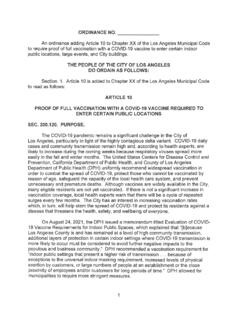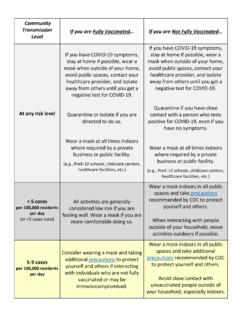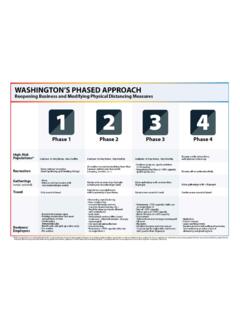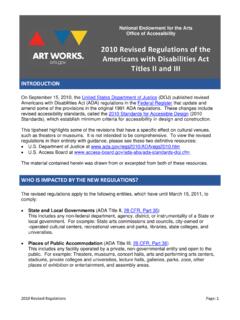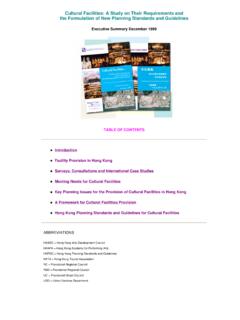Transcription of The Use of Cooling Centers to Prevent Heat-Related Illness ...
1 The Use of Cooling Centers to Prevent Heat-Related Illness : Summary of Evidence and Strategies for Implementation Climate and Health Technical Report Series Climate and Health Program, Centers for Disease Control and Prevention Stasia Widerynski,1 Paul Schramm,1 Kathryn Conlon,1 Rebecca Noe,2 Elena Grossman,3 Michelle Hawkins,4 Seema Nayak,5 Matthew Roach,6 Asante Shipp Hilts5 1 Climate and Health Program, Division of Environmental Hazards and Health Efects (DEHHE), National Center for Environmental Health (NCEH), Centers for Disease Control and Prevention (CDC) 2 Health Studies Branch, Division of Environmental Hazards and Health Efects (DEHHE), National Center for Environmental Health (NCEH), Centers for Disease Control and Prevention (CDC) 3 University of Illinois at Chicago 4 NOAA National Weather Service 5 New York State Department of Health, Center for Environmental Health 6 Arizona Department of Health Services The fndings and conclusions in this report are those of the author(s) and do not necessarily represent the ofcial position of the Centers for Disease Control and Prevention.
2 The authors would like to acknowledge Dana Hyland, Marcus Sarofm, Emma Zinsmeister, and Joanna Taliano for their contributions to this document National Center for Environmental Health Division of Environmental Hazards and Health Effects CS280845-A ii The Use of Cooling Centers to Prevent Heat-Related Illness : Summary of Evidence and Strategies for ImplementationiiiContentsExecutive Summary ..1 Background ..2 Literature Summary: Effectiveness of Cooling Centers ..5 Climate Change and Energy Use ..18 Implementation of Cooling Centers ..19 Research Gaps ..23 References ..27 Appendix.
3 31 The Use of Cooling Centers to Prevent Heat-Related Illness : Summary of Evidence and Strategies for ImplementationThe Use of Cooling Centers to Prevent Heat-Related Illness : Summary of Evidence and Strategies for Implementation Executive Summary Extreme heat is a major public health concern in the United States. The trend of increasing frequency and duration of heat events ( heat waves ) is expected to continue in the future. Exposure to extreme heat can cause a variety of health problems, including heat stroke and even death. Public health departments, their partners, and other government organizations have undertaken a variety of strategies to protect the public from high temperatures.
4 The use of Cooling Centers , a cool site, or air-conditioned building designated as a safe location during extreme heat, is a common strategy. This document is intended to give a summary of the efectiveness of Cooling Centers , with a focus on highly relevant peer-reviewed literature. It also provides an overview of steps for the implementation of Cooling Centers . 1 The Use of Cooling Centers to Prevent Heat-Related Illness : Summary of Evidence and Strategies for Implementation Background As the most recent US Global Change Research Program report notes, changing climate conditions are a threat to human health, with negative impacts expected to increase in the Heat-Related Illness is one health impact that will be afected by climate change.
5 Temperatures have already increased across much of the United States, with an average increase of F to F since record keeping began in The most recent decade was the warmest on record, and globally 2016 was the warmest single year since modern record keeping This temperature increase is projected to continue, with longer, more severe, and more frequent heat waves Heat endangers human health in many ways, under many diferent scenarios. Long term temperature increases, extreme heat events, Heat-Related drought, high nighttime temperatures, and urban heat islands all impact health.
6 Heat-Related Illness is one health impact that will be directly afected by climate change. Health efects include heat cramps, heat exhaustion, heat stroke, and ,5 Extreme heat events can be characterized by temperatures that are much warmer than the seasonal average. Exposure to several days of extreme heat, sometimes called heatwaves, have a potential to cause a large number of deaths in a short time period. The 1995 Chicago heat wave resulted in over 700 deaths and thousands of cases of Heat-Related emergency room In some years, heatwaves cause more deaths in the United States than any other weather-related disaster, including hurricanes and ,8 The exact number of deaths is difcult to quantify as heat is often not mentioned as a specifc cause of death on death certifcates, potentially leading to an underestimation of the health impacts of Outside workers, older adults, children, communities of color, the homeless, individuals with a mental health disability.
7 Individuals with chronic medical conditions, individuals without access to air-conditioning, and low-income communities are particularly vulnerable to Heat-Related Heat-Related Illness is largely preventable, and health departments, federal agencies, state and local governments, and others are taking steps to prepare for warmer temperatures in a changing climate. Some health departments are utilizing The Centers for Disease Control and Prevention s (CDC) Building Resilience Against Climate Efects (BRACE) framework to help prepare and implement adaptations to protect During step three of BRACE, assessing public health interventions, health departments may choose to examine the usefulness of various heat adaptations in their jurisdiction.
8 There are many tools and programs that can be used to protect the public from extreme heat, including adoption of a heat-alert system, use of real-time data and surveillance to monitor health outcomes during heat events, built environment strategies ( , tree-planting, cool roofs), zoning regulations, heat safety education campaigns, wellness checks, and hydration stations. A health department may not have the authority, resources, or expectation to implement most interventions, but can be an important leader and partner. 2 The Use of Cooling Centers to Prevent Heat-Related Illness : Summary of Evidence and Strategies for Implementation One potentially efective and widely used adaptation option is the implementation of Cooling ,12 Access to air conditioning can Prevent Heat-Related morbidity and Low-income populations may have limited access to air conditioning12 or may be hesitant to operate air conditioning and Cooling units due to potentially high electricity costs during peak heat hours.
9 Cooling Centers can provide a cool environment for these individuals. Although there is currently limited direct evidence of the direct health impacts of Cooling Centers in the peer-reviewed literature, Cooling Centers are commonly used across the They are a relatively low-cost strategy that can utilize existing infrastructure and personnel and be relatively easily implemented by a variety of stakeholders. Their use has a high biological plausibility for reducing Heat-Related Illness and death. Heat is a well-known health threat, and it is logical that a relatively cool environment reduces heat exposure and prevents negative health outcomes.
10 However, the best strategies for efective implementation of Cooling Centers are unclear. Figure 1 outlines the simple pathway by which implementation of Cooling Centers protects health. Cooling Center Analytic Framework Figure 1: Simple framework demonstrating the causal pathway for Cooling Centers preventing Heat-Related Illness 3 The Use of Cooling Centers to Prevent Heat-Related Illness : Summary of Evidence and Strategies for Implementation Signs for free water at a Cooling center in Maricopa County, Arizona. What is a Cooling Center? A Cooling center (or Cooling shelter ) is a location, typically an air-conditioned or cooled building that has been designated as a site to provide respite and safety during extreme heat.










